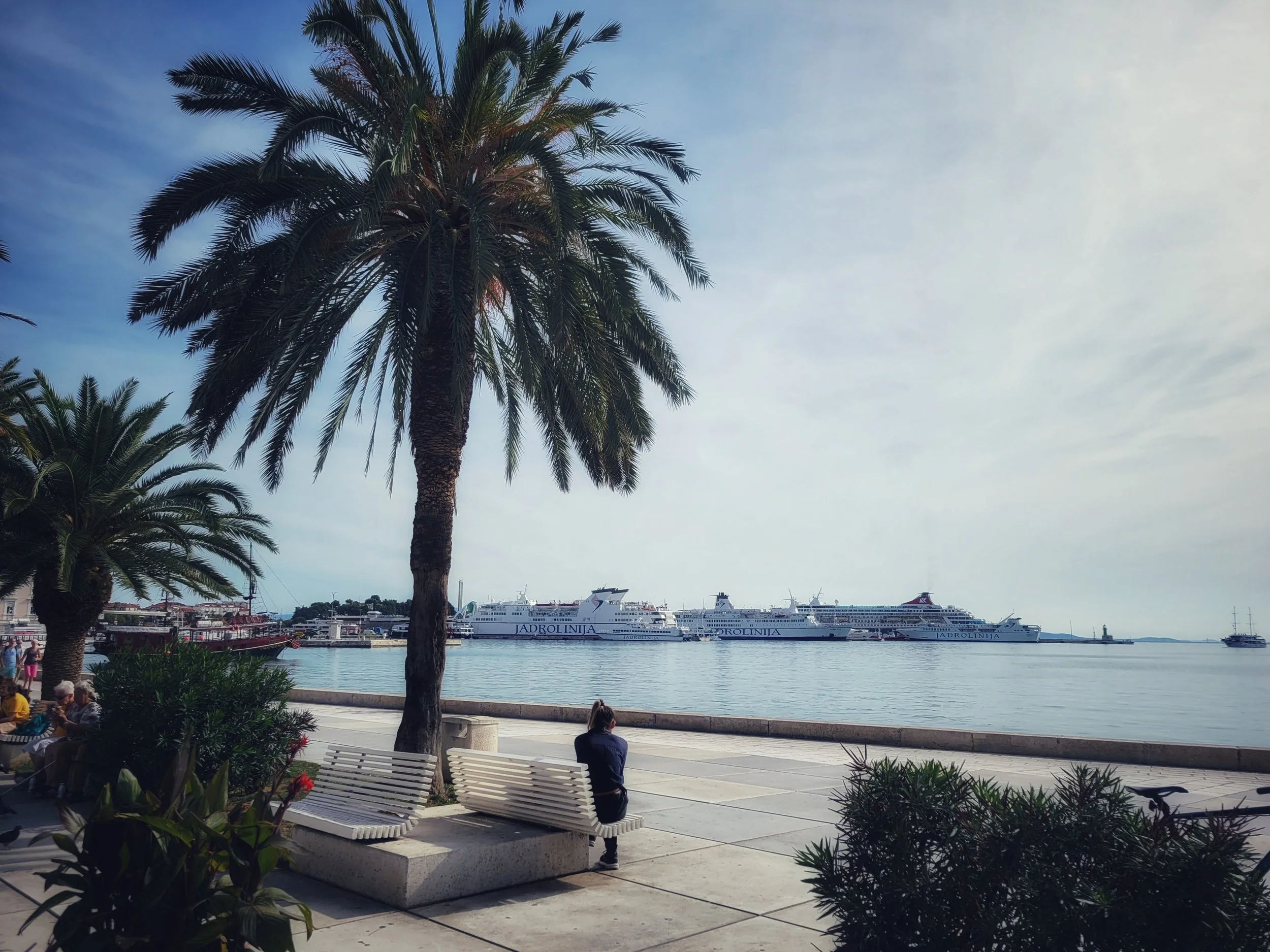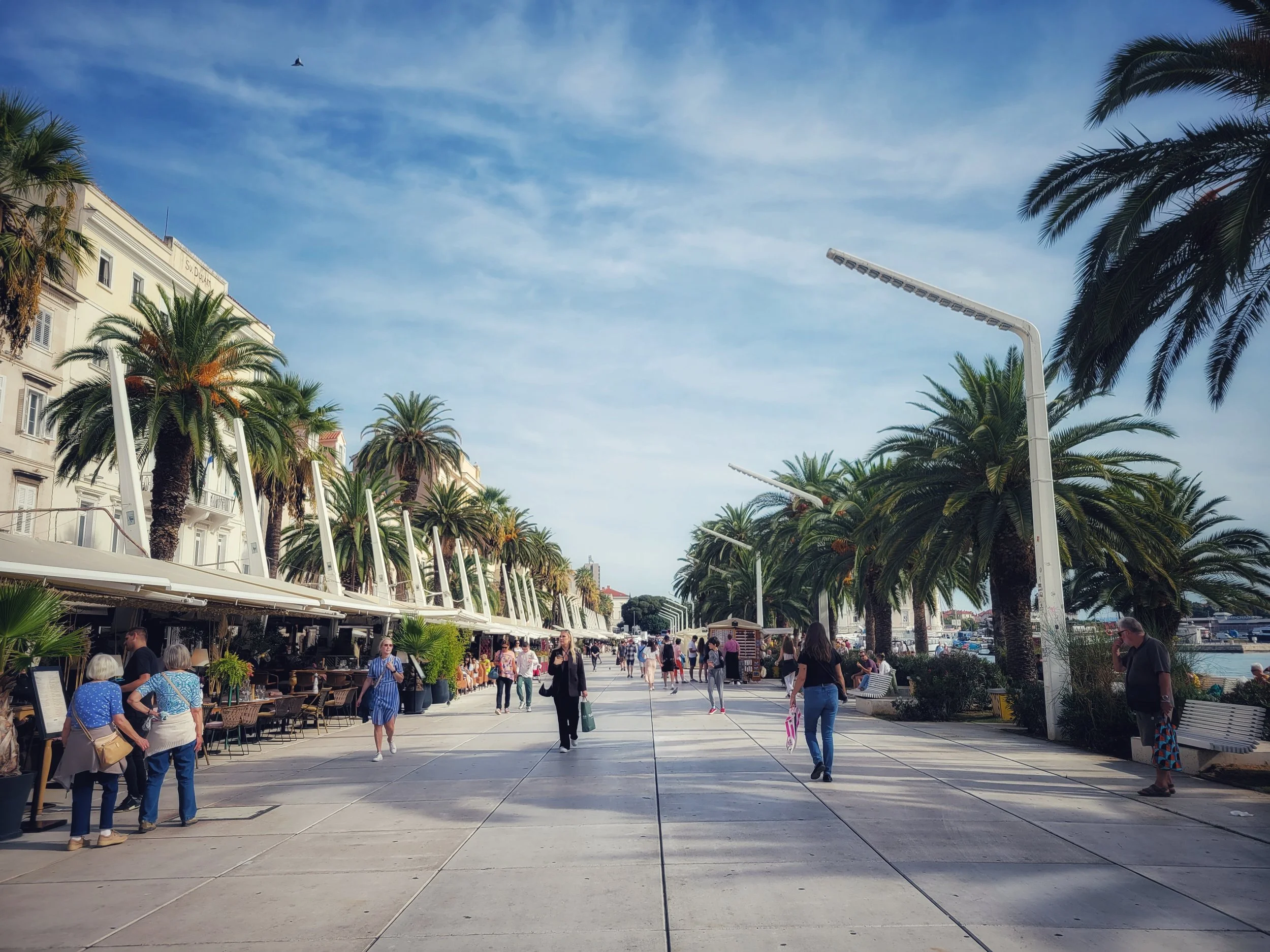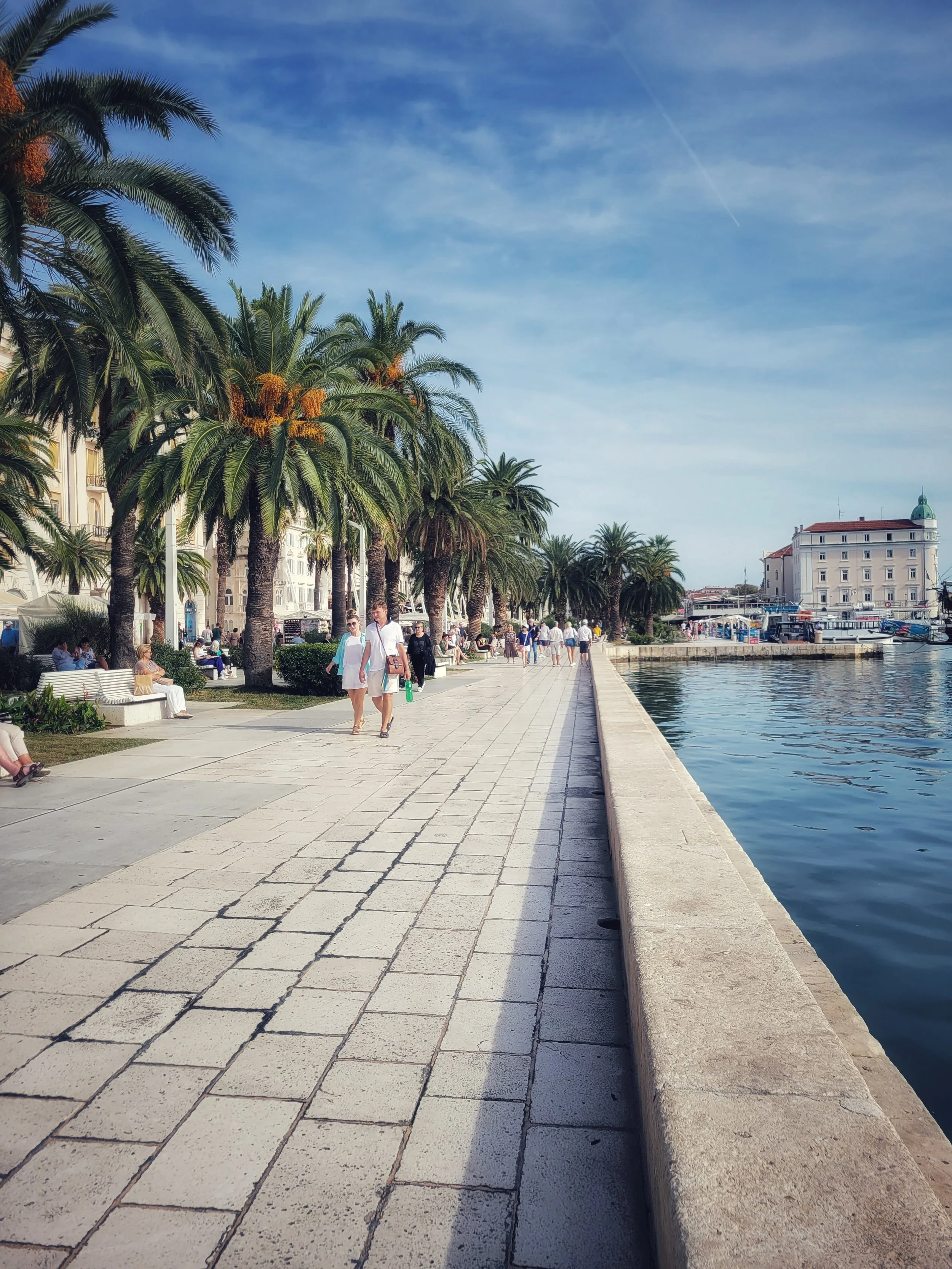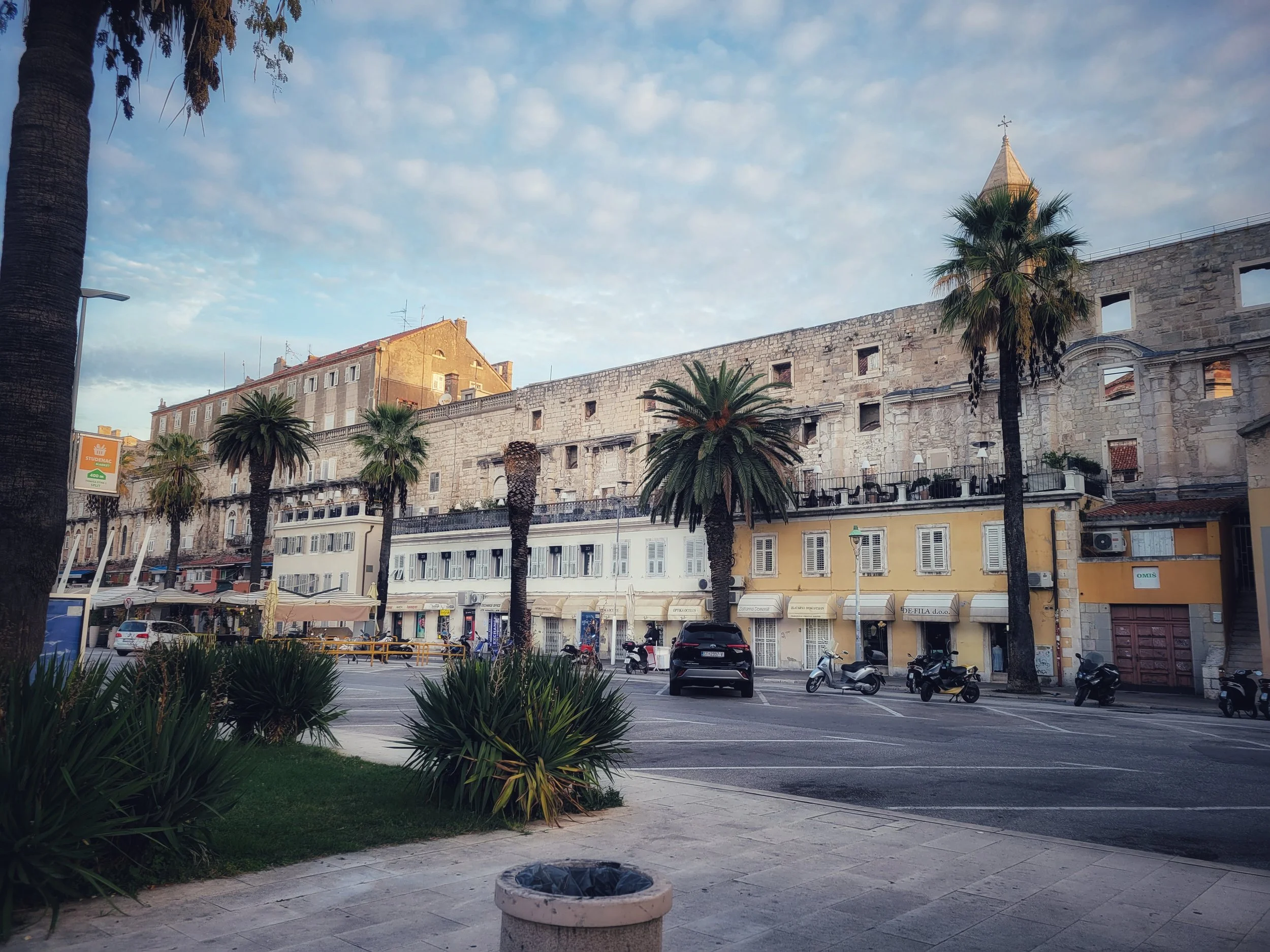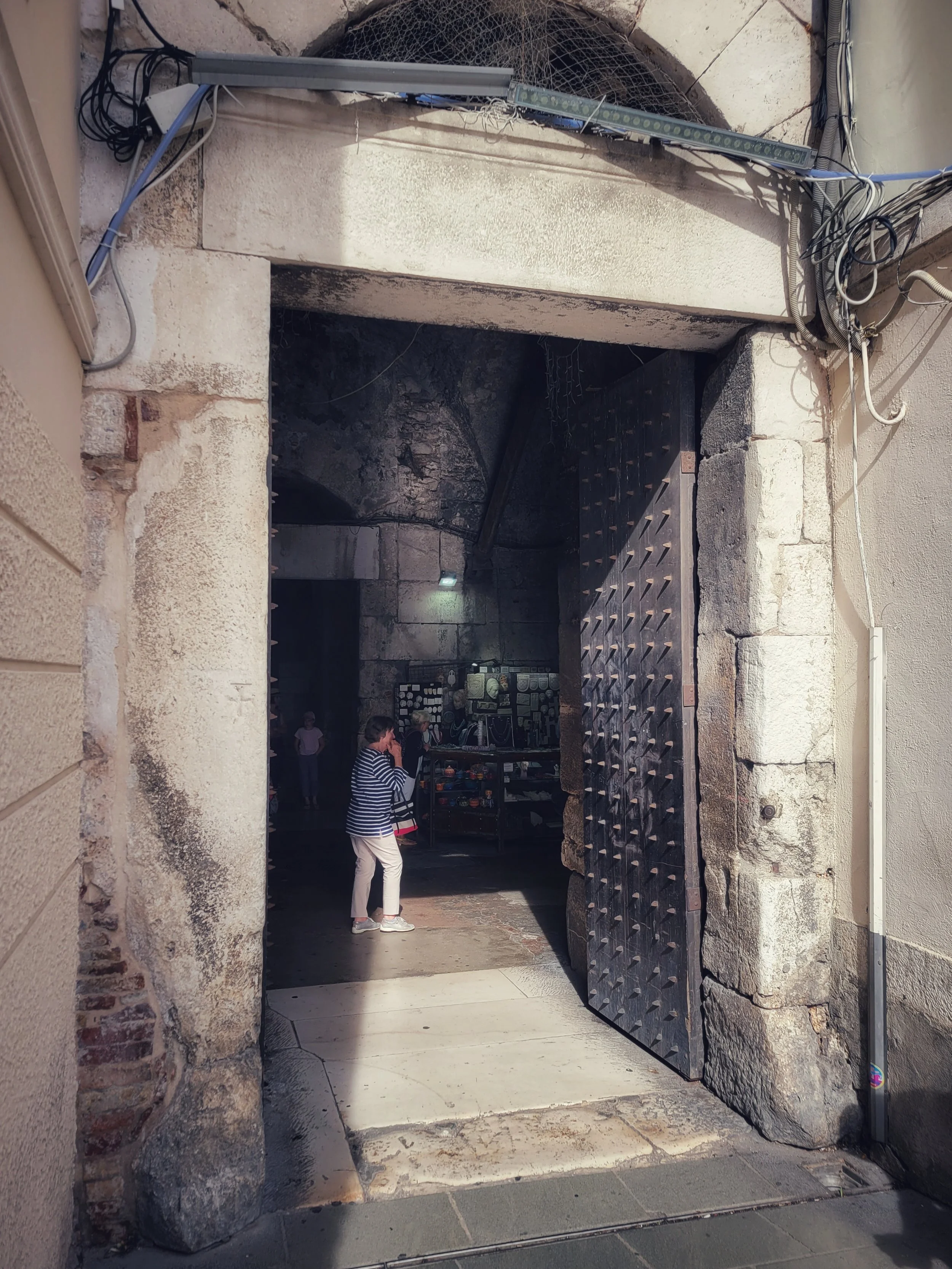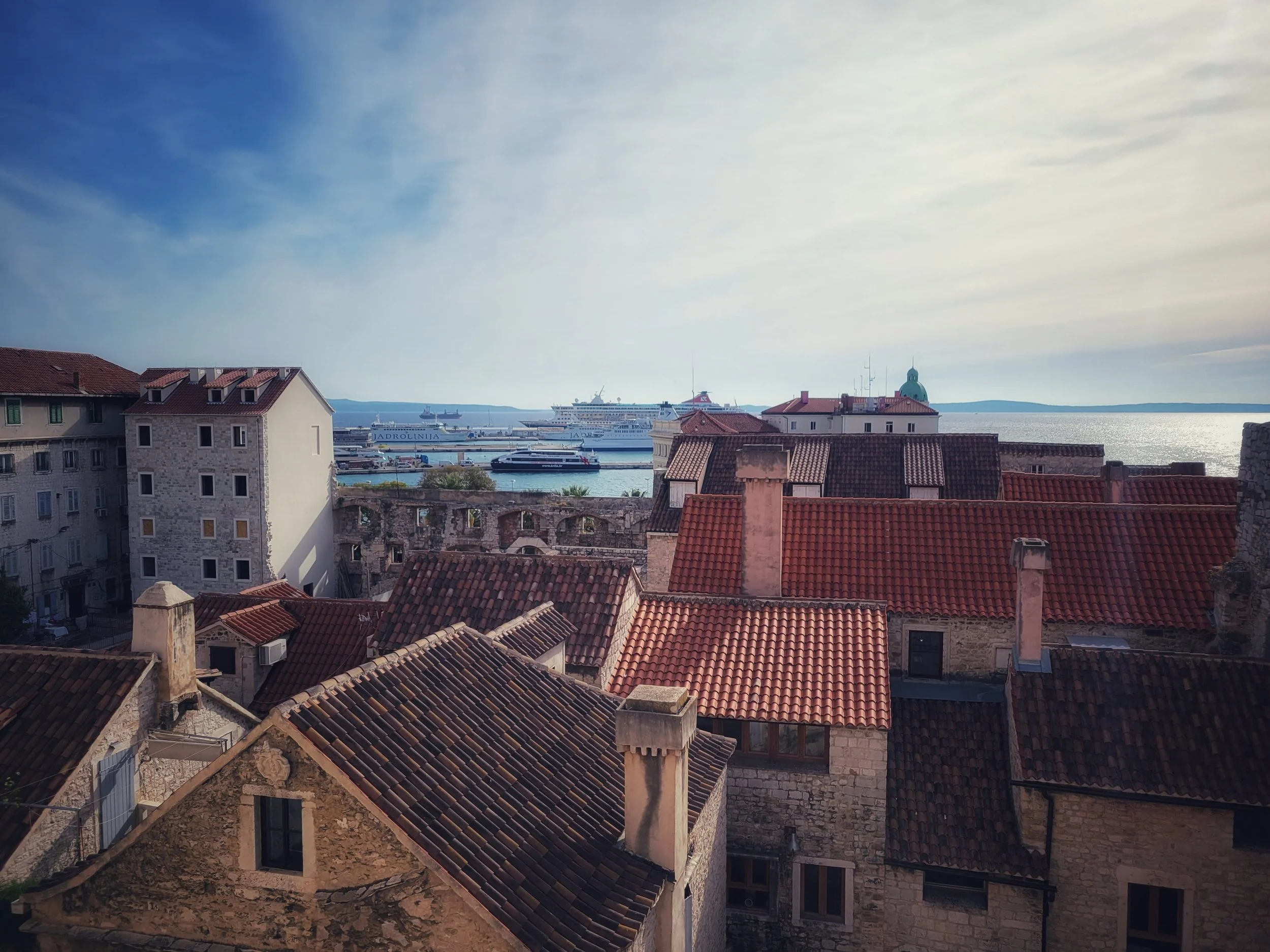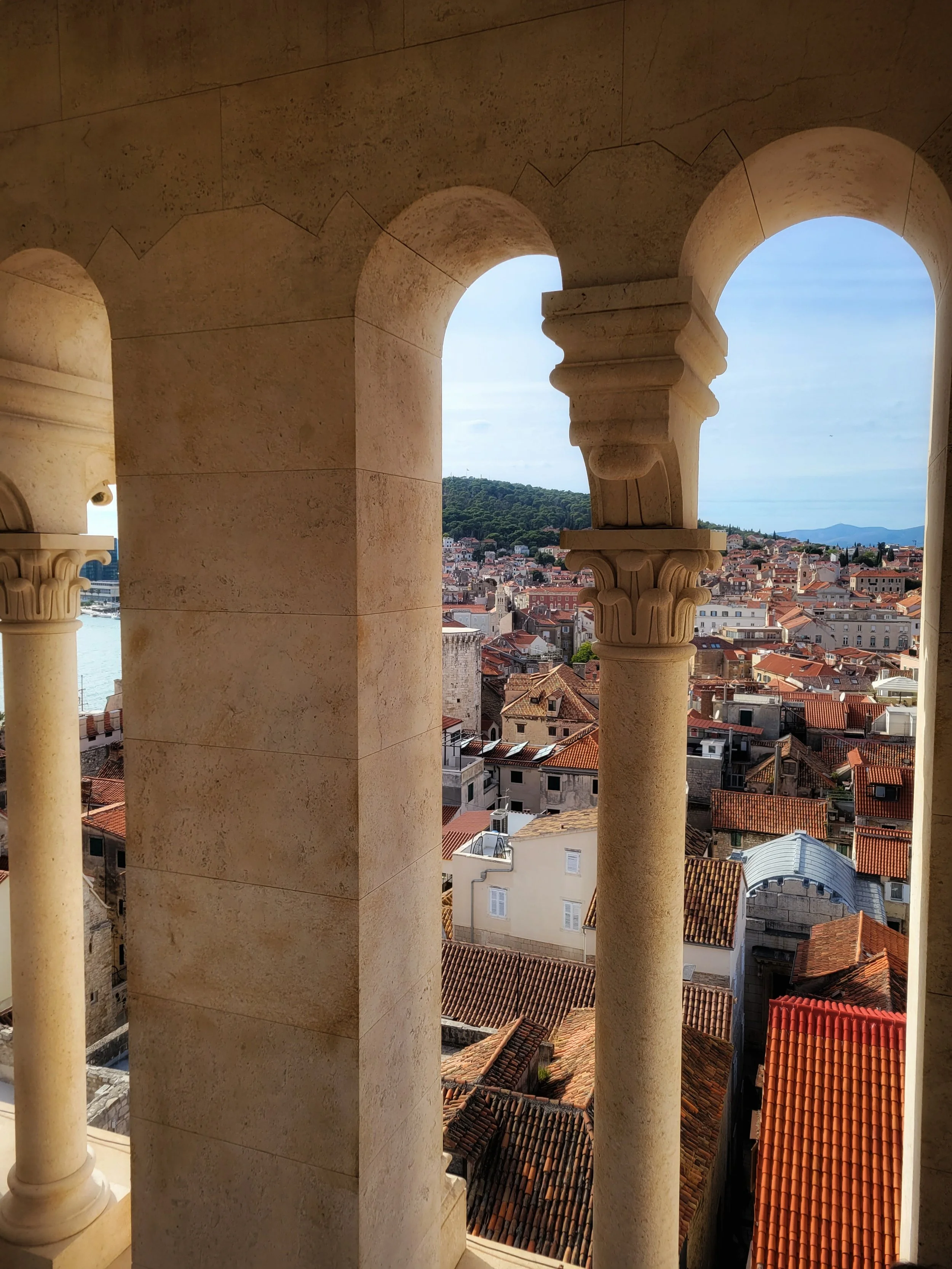Split, Croatia
Dalmatian Seaside City Brimming with Roman Ruins & Natural Splendor
Officially the Republic of Croatia, Croatia is a hidden gem located between Central and Southeastern Europe. Its coast lies entirely on the Adriatic Sea while bordering Slovenia, Hungary, Serbia, Bosnia and Herzegovina and Montenegro. Croatia is a rugged land known for stunning beaches, medieval castles and rocky coastlines. Its Game of Thrones appeal feels wildly magical, while the cuisine, specifically seafood and wine, are worth the visit alone. Consistently sunny skies don’t hurt either, though, and the waters can be quite crisp.
Historically known as Spalato, Split is Croatia’s second largest city after its capital, Zagreb. Split lies on the eastern shore of the Adriatic Sea and is a popular destination for tourists looking to explore Croatia’s ancient architecture, wander the grandeur of Diocletian's Palace and island hop across some of Croatia’s more than 1,000 islands that dot the pristine Dalmatian coast. About an hour by speedboat, Blue Cave is a naturally formed cave that turns bright blue on sunny days. On the island of Vis, Stiniva Cove lies hidden behind a narrow opening of tall sheer rocks, only reached by dingy or swimming. Blue Lagoon is a gorgeous lagoon with untouched waters where visitors swim, sunbathe and enjoy idyllic views. And Hvar Island, one of the larger in the area, is known for its nightlife scene, delicious cuisine and historic town center.
With two weeks to explore both Croatia and Montenegro, I first landed in Dubrovnik, the Pearl of the Adriatic, followed by a day trip into Mostar, Bosnia and Herzegovina, Little Gem of the Balkans. From Dubrovnik, I moved north up the coast by ferry to Split, a Dalmatian seaside city brimming with Roman ruins and natural splendor, then jumped on a speedboat to experience Blue Cave and Island Hopping, and finally, visited central Croatia for Plitviče Lakes National Park. On my way out of Croatia, I passed through its capital and flew on to Podgorica, Montenegro’s capital, then made my way to Adriatic’s Coastal Medieval Town of Kotor and joined day trips to both northern Montenegro for Durmitor National Park, Tara Canyon & Ostrog Monastery and greater Montenegro to experience Lovćen’s Mausoleum, Royal Old Capital & Skadar Lake.
Arrive in Split & Gorge on Delicious Pizza
Getting to Split was quite an adventure. I began in Dubrovnik and hopped on a ship up the coast for only $12 USD. The journey lasted five hours, stopping multiple times along the way at islands, Pomena, Korcula, Hvar, Milna and ultimately, Split. The boat ride was pleasant. One of the staff members was kind enough to let me get some fresh air outside on the boats bow, right in front of the captain’s chair. I felt honored until we got on open waters and it was far too cold to enjoy; I moved inside to warm up.
Once the boat docked in Split, we piled off one by one. Sluggishly, I wandered into town, reaching my hostel, Hostel Dvor, within about 15 minutes. The walk was straightforward until I hit the cobblestones and had to bump over each and every stone with my suitcase. Ravenous and irritable, I took off on foot in search of food; it was getting late and I was worried restaurants would be closing. With luck, I found a charming place in Old Town called Mediterraneo Restaurant & Pizzeria. Dining alfresco, I ordered a greek salad with huge lumps of fresh feta and a large pizza covered in olives, artichokes and prosciutto. It was absolutely perfect and I gobbled up as much as humanly possible.
Brunch at Ciri Biri Bela
In the morning, I woke for my first day of exploring Split. My first day in a new city is always something special. With no idea what to expect, I step out and see where the day takes me. Getting a feel for the layout of the city, I start to create a list of stops I’d like to make along the way. First up, though, breakfast at Ciri Biri Bela, just a few blocks from my hostel. The reviews looked outstanding and once I arrived, I knew I’d made the right decision. Behind a thick white stone wall and a few steps below street level, I entered a beautiful courtyard and found a seat.
In an absolutely stunning display, my order arrived at the table on wood carving boards and in beautiful ceramic dishes; a dirty chai latte and Women’s Health spread included so many delicious treats. Freshly baked French bread, fried eggs, vanilla yogurt topped with fruit and nuts, smoked salmon, wasabi cream cheese, cheeses, jams, butter and grapes, apricots, cantaloupe and kiwi. It was almost too beautiful to eat.
Full of flavor, fresh and tasty, breakfast was perfect and service was incredibly kind and helpful. To takeaway, I couldn’t pass up an almond croissant made by their personal French baker. After my meal, I stopped in a tour agency to set up a few plans, including the Blue Cave tour for 800 HRK (Croatian Kuna at the time but is now officially the euro/EUR), or $115 USD, and transportation to Plitviče Lakes in Central Croatia. Then, I let loose at Zara.
Stroll Seaside & Enter Diocletian's Cellars
The shimmering waters of the Adriatic Sea meet Split in a soft and genuine way. Yachts and larger boats are docked on the waters, far enough away to not make much of a presence. The waters are calm and smooth and move alongside a gorgeous promenade called the Riva.
The Riva is Split’s gorgeous palm lined esplanade that began to take shape two centuries ago when the French (and Napolean) ruled these parts through Marshal Marmont, a French general and nobleman. The Riva sets the stage for Split, the perfect spot for morning coffee or an evening stroll along the waterfront. It’s also home to the south facade of Diocletian’s Palace with an entrance opening up directly into its underground cellars.
The city of Split was founded as the Greek colony of Aspálathos during the 2nd or 3rd century BCE, while in 305 it became home to the Roman emperor, Diocletian. Diocletian worked hard to revive glory as ruler; his reforms brought back order to the Roman Empire as he worked to create a ruling model called Tetrarchy where four rulers each rule a portion of the Empire, stepping down after 20 years. Though Tetrarchy failed on many accounts, Diocletian retired after his 20 year rule to his palace in Split, living another 10 years before passing of natural causes. Nearly 300 years later, the nearby city of Salona was destroyed by invasion from Eastern Europe and most of its inhabitants fled to the palace. It was then that Split was truly born. A bronze model along the Riva depicts the city as it is today, with many additions over the centuries.
Most remarkable, opposing the sea, is the southern facade of Diocletian’s Palace which was specifically designed for the Emperor’s residence on the other side. The architect hoped to create a mass connected to the outside world, incorporating an arcade full of windows that open up onto the Riva and the Adriatic Sea. At first glance, the wall may look bizarre but it projects upward with various shops and balconies built in front of it.
A UNESCO World Heritage Site since 1979, Diocletian’s Palace was built for Roman emperor, Diocletian, at the end of the third century AD and forms about half of old town Split. Built from local limestone and white marble, the palace is still in rare form, with most of its structure well preserved, particularly the exterior walls (other than the western wall). Interestingly, it’s said that the emperor wished to enter his palace by ship without leaving the deck, so much of what we consider the lower level was once covered in water. Over time, the sea receded, leaving the city as it is today. And though the structure is referred to as a “palace” and intended as a retirement residence, the complex is enormous and resembles more of a fortress than anything else.
The palace had four gates, three of which remain today. The southern portion of the palace was reserved as residential space, while the central area was used for religious and ceremonial purposes and the northern, compounds for soldiers, servants and possibly slaves. The Southern Gate, or Bronze Gate, was likely meant to move goods into the palace from ships in the bay. Through this gate are the basement cellars.
The cellars of Diocletian’s Palace represent the largest surviving Roman indoor space in the world and one of the most well preserved complexes of its kind. This area is largely the reason why the historic core of Split was included in the UNESCO World Heritage Site. Its construction mixes both ancient and eastern elements.
In Roman times, the cellars function was to raise the emperor's living quarters on the floor above, as well as a storage area for the palace. As a structural copy and the largest covered space from the period, the cellars provide a pretty good idea of the spatial structure and appearance of the former imperial chambers located above.
Over the years, the cellars have been used for several purposes. In the early Middle Ages, part of them were for housing, with one of the halls dedicated to the production of oil and wine with a turnjačica, or wine press, which is still on display today. As construction of the palace continued, the basement became a waste receptacle for residents above. During the middle of the 19th century, architect Vicko Andrić began to clear out the basement, excavating and reconstructing the space to its present form. The eastern portion of the cellars only opened to the public relatively recently in May 1995.
Today, the cellars are active and full of life. The space is used for a myriad of social and cultural activities and events like art exhibits, theater performances and gastronomic and oenological (science and study of wine and wine making) events. But on most days, the cellars are used by vendors to sell goods and as a gallery space.
Stepping underground into this space gives a feeling of grandeur and greatness. Though dimly lit and damp, arched stone ceilings tower high above with massive square columns rising to meet them. The air is cool and moist but vendors tucked between columns displaying handcrafted goods for sale, don’t seem to mind.
The central hall, or main corridor, stretches from the Riva to a set of stone steps that rise into the main courtyard of the palace and the Peristyle; a row of columns surrounding an interior space.
Praise Central Square of Diocletian's Palace
The inner courtyard of Diocletian’s Palace is surrounded by a Roman peristyle with a columned gallery. Bookended by a prothyon (porch or vestibule in front of a home) where Diocletian's throne once stood, the nearby portal leads directly into the emperor’s chambers. The southern portion of the private imperial chambers included an unpreserved cryptoporticus, a large arcaded corridor overlooking the sea, and baths whose remains have been preserved.
Emperor Diocletian, celebrated as the living son of Jupiter, would appear under the arch of the central prothyon as subjects approached him in a ceremonial fashion, kneeling and kissing the folds of his crimson cloak, or falling and laying their whole bodies on the ground in worship.
After the death of Diocletian, the city was abandoned for the most part. The palace remained an imperial possession of the Roman court, offering shelter to the expelled members of the Emperor’s family. Diocletians remains were housed in the mausoleum built within the palace. It was only in the 7th century that new construction began to unfold. During which time, Italians called the city Spalato and later, the Slavic Croatians who replaced them, renamed the city to Split.
Likely around this time, Diocletian’s mausoleum was rebuilt into a Christian church with a five-tiered bell tower, the Romanesque bell tower of the Cathedral of Saint Domnius. Over time, some level of antiquities were removed or destroyed, even the sarcophagus of Diocletian himself disappeared from the mausoleum; its fate still unknown.
After taking in the totality of the Peristyle, I wandered further back into the space, eyes wide open. In the rear, ruins continued to spread on as far as I could see, arcades pushing up into the blue sky. Vendors had paintings on display, while visitors looked on. Others posed for photos in the main courtyard or sat on purple cushions to people watch.
The floor plan for the palace is an irregular rectangle with 16 octagonal towers projecting from the northern, eastern and western facades. On each facade, a monumental gate in the middle of each wall leads to an enclosed courtyard. To the east, I located the Silver Gate, or Porta Orientalis. Originally a secondary gate, it faces toward the Roman town of Epetia.
Around the 6th century, a small church was built and dedicated to St. Apolinar above the East Gate, likely because of the influx of refugees from remote lands. Similar churches were built over the other gates: Golden Gate (North Gate), Iron Gate (West Gate) and Bronze Gate (South Gate).
From the central square there are a handful of noteworthy sites to visit, some of which I didn’t realize at the time, like the Treasury and Baptistry. Additionally, visitors can climb up to the top of the vestibule for incredible views of the city and fewer crowds.
The Treasury is a museum holding artifacts dating from the original palace to the 18th century, most of which consist of religious artifacts.
The Baptistry, or Temple of Jupiter, is a temple dedicated to the ancient Roman god Jupiter. Built between 295 and 305, it’s located in the western part of Diocletian’s Palace down a narrow pathway from the Peristyle.
One of 12 black sphinxes brought from Egypt by Emperor Diocletian lies at the entrance, marking what is now a Christian chapel. The site was likely turned into a baptistry in the 6th century, the same time when the crypt dedicated to St. Thomas was built.
Though visiting the central courtyard is free of charge, many of the other sites require a ticket. Pricing is currently as follows:
Blue ticket for €7 euro includes 3 sites: Cathedral, Crypt, Baptistery
Green ticket for €10 euro includes 3 sites: Cathedral, Bell Tower, Treasury
Red ticket for €8 euro includes 4 sites: Cathedral, Crypt, Baptistery, Treasury
Purple ticket €11 euro includes 5 sites: Cathedral, Crypt, Baptistery, Treasury, Bell Tower
Show Reverence at Cathedral of Saint Domnius
The Cathedral of Saint Domnius, known locally as the Sveti Dujam or Sveti Duje, is the Catholic cathedral in Split. The cathedral is the seat of the Archdiocese of Split-Makarska, with an Imperial Roman mausoleum and bell tower forming a church complex. The church is strictly dedicated to the Virgin Mary, while the bell tower to Saint Dominius.
With access to the east of the Peristyle, the Cathedral is composed of three sections from different ages. The central portion is Emperor Diocletian’s mausoleum, dating to the end of the 3rd century. Built in a similar fashion as the rest of the palace, the mausoleum was built with local white limestone and marble. In the 17th century, a choir was added to the eastern side of the mausoleum, tearing down its eastern wall to combine the two chambers. And later, a Romanesque bell tower was erected in 1100 AD.
Upon entering the cathedral, everything fell silent in a single moment. A beautifully shaped and highlighted dome rose high above, light cascading off each surface in the dimly lit space. Intricate details shown throughout, particularly on the plaster columns and stunning reliefs.
My particular interest were the gorgeously carved wooden doors, which almost resembled a deep toned brass. One of the best examples of Romanesque sculpture in Croatia, the massive wooden doors were made by the medieval Croatin sculptor and painter, Andrija Buvina, around 1214. The two doors each contain 14 scenes from the life of Jesus Christ separated by richly ornate patterns.
On the first floor of the sacristy, a treasury contains relics of Saint Dominus brought to the cathedral after his death.
Various other treasures include a number of well known sacred texts from as early as the 6th century, as well as art pieces such as the Romanesque The Madonna and Child panel painting from the 13th century, chalices and shrines made by goldsmiths from the 13th to the 19th centuries and various robes from the 14th to the 19th centuries.
Originally, the site was intended as a mausoleum for Emperor Diocletian, becoming his grave after death but that’s not how things ended up. During his rule, Diocletian expelled Christians hiding on nearby islands, killing some and persecuting others. Centuries later, after his death, Christians returned to Split and removed Diocletian’s sarcophagus from the mausoleum. They placed in the bones of martyr and bishop of Salona, Saint Domnius, which are still in the church today. The building became a Cathedral soon after.
The cathedral was dedicated at the turn of the 7th century AD and is regarded as the oldest Catholic cathedral in the world that remains in use in its original structure, without massive renovation at a later date, though the bell tower dates from the 12th century.
The structure itself, built in AD 305 as it was originally intended as the Mausoleum of Diocletian, is the second oldest structure used by any Christian Cathedral.
Ascend Saint Domnius Bell Tower
Standing 187 feet tall, the Saint Domnius Bell Tower began construction around 1100 AD and some say, lasted over 300 years. It was built primarily in Romanesque style but due to the length of its construction, other styles are noticeable. The bell tower was completely reconstructed and somewhat altered in 1908, removing many of the original Romanesque sculptures.
Climbing the steep steps of the bell tower was mostly done in dim light. Sunlight lit the stairs, only passing through small and rare arched windows placed sporadically. As each passing window arrived, so did better views of the city below.
Once high enough, it was possible to see over the terra cotta tiled roofs to the sea where large boats and cruise ships were anchored. Sunlight shimmered across the smooth waters. Trails like those left by snails crawled across the waters surface; clues from the past.
Looking down into the streets of Split, I was able to see just how dense the city was. Narrow streets carved between tall white buildings with tile rooftops like a meandering river.
I was also enchanted with the mechanics inside the bell tower. Presumably meant to assist with ringing the bell, there were a number of pulley systems caged inside the tower.
The five-tiered bell tower is particularly popular with tourists looking for unforgettable panoramic views of Split and the surrounding islands so move slowly and use caution, holding on to the rail when possible.
The climb down was much easier than expected, though, the stairs are narrow and incredibly steep. Visitors need to shift to the side as others pass by but the climb was absolutely worth the effort.
Once I arrived back on stable ground, I took a few moments to rest before continuing.
Witness A Cappella Singing in the Vestibule
Continuing to wander through the narrow corridors, I discovered a boutique selling local artwork and other unique handcrafts. I picked up a bar of locally handmade soap and a metal campers mug with ‘Split’ painted on the front.
Eventually, I came upon the Vestibule (Vestíbulo), or Atrium or Rotunda, in the first section of the Imperial corridor of Diocletian’s Palace leading to the Peristyle. Once the formal entrance to the Imperial apartments, the Vestibule has a square exterior and a circular interior. To the southeast of the vestibule is the medieval quarter, with the oldest building, an early Romanesque house from the 10th century. Oppositely, lies the church of Saint Andrija, now part of teh Ethnographic museum.
Built alongside the rest of the original ancient palace at the beginning of the 4th century, this space was constructed as a grand meeting hall for special occasions. The circular hall was once topped with a dome of colorful shiny mosaic tiles reaching 55 feet high and 40 feet in diameter. The entrance was secured with a large door covered in relief patterns and there were four semicircular niches with statues of unknown deities.
With the dome now gone, the sunlight makes the vVstibule of Diocletian’s Palace shine bright once more. The contrast of bright blue sky against the white stone is palpable and the scale of the Vestibule looks and feels as monumental as ever. With incredible acoustics, these days the space is used for more informal performances by klapa singing groups. Klapa singing is a multipart singing tradition of the southern Croatian regions of Dalmatia done in a cappella, or singing without instrumental accompaniment.
Typically performing popular folk songs during the summer months, these a cappella groups take full advantage of the acoustics in the Rotunda. Singers stand in a semicircle and perform to gathering crowds who donate what they see fit. The music is now considered part of the UNESCO Intangible Cultural Heritage of Humanity.
As a wonderful example of blending traditions in both ancient and modern culture, I was thrilled to catch one of these magical performances during my stay in Split.
The residential part of the palace is then entered through the Vestibule.
Enter Diocletian's Living Quarters
Once through the Vestibule, the Emperor’s apartment began to unfold. The area forms a block along the southern edge of the palace at the seafront, with an exterior square, circular floor plan and dome. The Emperor’s apartment stretches 130 feet deep along the entire south facade. Today, the upper floor is only partly preserved but the ground level is almost completely preserved.
On the west side of the upper floor are the remains of a dome hall and two halls with niches. On the east, are parts of an octagonal dining room with three halls in a cross floor plan; the wall of the Western Cross Hall preserved at full height.
Diocletian’s apartment was also unified by a long room along the southern facade with 42 windows and three balconies that open to views of the sea. As of late, two baths were found north of the Emperor’s apartment.
It was also possible to catch mouth watering views of the bell tower from a new vantage point.
As I wandered through the space, I particularly enjoyed imaging the space coming to life, with people roaming around, green gardens blooming and animals like chickens clucking about.
Dine at Fig Split
In the late afternoon, after many hours of exploring, I sat at Fig Split for lunch. Happy to be off my exhausted feet, I sat in their sun soaked courtyard and ordered up a storm. With a fresh and creative take on local ingredients, Fig Split offered some interesting dishes. To drink, I chose a virgin cherry spritz, and for my meal, roasted veggies with sweet potatoes, leeks, fennel, carrots and beets served on house made white bean hummus with lemon and lamb’s lettuce.
As id that wasn’t enough, I chose the chimichurri potatoes, smashed and fried red potatoes served with vegan chimichurri mayo.
Overall, my meal was pretty tasty but service wasn’t as great. Sadly, I also got incredibly sick about an hour later; it was food poisoning. Hopefully, it was a fluke but be careful at this spot.
With a nasty case of food poisoning, I had to skip out on my Blue Caves tour the next day but I was able to talk the gentleman into letting me join the following day. Whew!
Blue Cave & Island Hopping
Croatian Islands
After my sun drenched and windblown day island hopping, I packed up my suitcases and met my group and tour guide down at the taxi station for a day tour to Plitviče Lakes National Park in Central Croatia. Planning to stay up at the lakes instead of catching the bus back to Split, I took along all my belongings.







